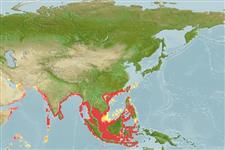Classification / Names
Common names from other countries
Main reference
Size / Weight / Age
Max length : 80.0 cm TL male/unsexed; (Ref. 7238); common length : 50.0 cm TL male/unsexed; (Ref. 7238)
Environment
Marine; brackish; demersal; amphidromous (Ref. 51243); depth range ? - 100 m (Ref. 9830)
Climate / Range
Tropical, preferred ?; 30°N - 11°S, 49°E - 127°E
Distribution
Short description
Dorsal
spines
(total): 0;
Anal
spines: 0;
Vertebrae: 143 - 149. Mouth very large, upper jaw reaches well behind eye (Ref. 4832). Length of pectoral fin about 3.2 in head; lateral line pores before anus 41-42; dorsal fin rays before anus 70-75 (Ref. 9830). Dorsal fin inserted before gill-openings (Ref. 4832).
IUCN Red List Status (Ref. 115185)
Threat to humans
Harmless
Human uses
Fisheries: minor commercial
More information
Common namesSynonymsMetabolismPredatorsEcotoxicologyReproductionMaturitySpawningFecundityEggsEgg development
ReferencesAquacultureAquaculture profileStrainsGeneticsAllele frequenciesHeritabilityDiseasesProcessingMass conversion
Tools
Special reports
Download XML
Internet sources
Estimates of some properties based on models
Phylogenetic diversity index
PD50 = 0.7500 many relatives (e.g. carps) 0.5 - 2.0 few relatives (e.g. lungfishes)
Trophic Level
4.0 ±0.66 se; Based on food items.
Resilience
Vulnerability
Low to moderate vulnerability (34 of 100)
Price category
